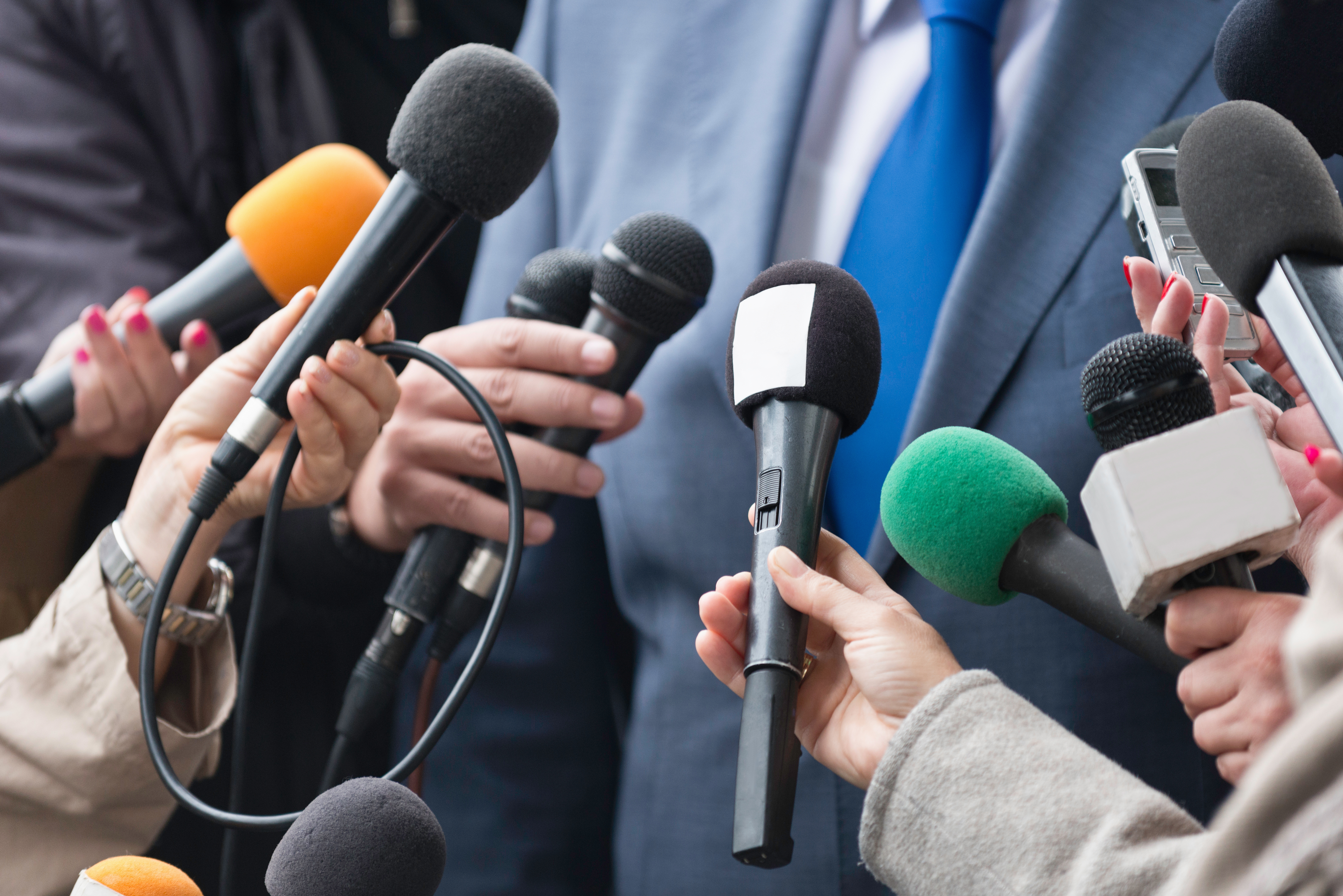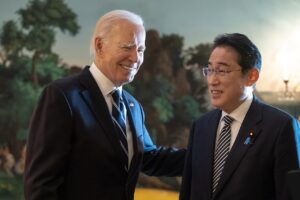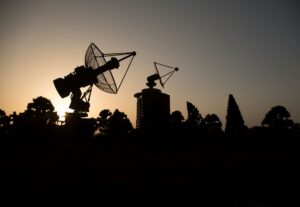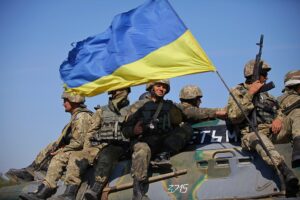In April of 2004, the streets of Abu Ghraib, Iraq, were agitated. The US Army had a camp on the outskirts of town that was growing as the American occupation of the country settled in for the long haul against a rising and mysterious resistance. Welcomed by many locals a year earlier as liberators, the Americans were increasingly viewed with suspicion, fear, and even a nascent disdain. Requiring unencumbered roadways for larger and heavier vehicles to access mushrooming trouble spots around the adjacent countryside, US forces uprooted markets that had lined Abu Ghraib’s commercial thoroughfares for millennia – and moved them to the edge of town, to what one US military official said would be a more modern, safer, and “mall-like” atmosphere.
Black and white banners invoking Allah and exhorting Abu Ghraib’s residents to join in expelling the infidels from their town and from Iraq had started appearing overnight, festooning buildings and roadways.
And then there was the matter of the happy turtle and death.
As the diplomatic correspondent for the Christian Science Monitor assigned to the newspaper’s Iraq rotation, I found myself that April on the streets of Abu Ghraib, an Iraqi translator helping me to understand what the locals were feeling about the growing US military presence in their midst. At one point a particularly impassioned young man looked at me, the only American in our small group, his eyes telling me he cared deeply about what he was saying.
“He says he wants to know why the Americans replaced the happy turtle with death,” the translator said. Perplexed, I asked for clarification. “He says that when the Americans arrived they were happy turtles, but now they are death, and he wants to know what that change means for the people of Abu Ghraib,” the translator said.
I was still scratching my head when suddenly the young Iraqi’s eyes widened and he pointed excitedly to a line of US Army Jeeps roaring by. One of them waved a giant flag with a skull and crossbones. “There, that’s it! What do the Americans mean with this death?” he pleaded. “Why have they brought this to Abu Ghraib?”
Later that day I would learn in an interview with one of the Abu Ghraib base’s senior officers that the skull and crossbones was “simply” the symbol of the battalion that had recently replaced one of the original army battalions at Abu Ghraib. And yes, as it turned out, the symbol of the Americans who first patrolled the town’s streets had been a smiling, goofy turtle.
The officer seemed completely caught off guard by my report of consternation and foreboding in the town over the change in symbols. He thanked me for the information – it was clearly a level of on-the-ground intel that was new to him. But he assured me that the skull and crossbones on the army vehicles should only have meaning for the battalion.
Later, I remember thinking back to the black and white banners (precursors of Abu Musab al-Zarqawi’s Al Qaeda in Iraq) that were cropping up around Abu Ghraib about the same time as on the American side, death was replacing the happy turtle. The Americans had no understanding of how their symbols might have an impact among locals attuned to symbols – any more than they understood how moving age-old markets out of the commercial center to a “mall-like” setting on the outskirts might not go over well.
My Abu Ghraib reporting was the beginning of a hunch that the American occupation in Iraq was not destined to go well.
I would continue to cover the Iraq war as part of the Monitor’s rotation for several more years, through the dark days of 2006-07 — when the AQI I’d first encountered through the group’s flags popping up in Abu Ghraib was running amok with horrific bombings in Baghdad and gains across the Sunni Triangle – into the improving times of 2009 and ’10. But I often thought back to my experience with the happy turtle and death in Abu Ghraib, and the questions that experience raised: Why weren’t the military officers who would lead the US occupation on the ground better prepared to understand the culture and ideally work with the communities they were assigned to hold and essentially to govern?
Why hadn’t there been better training and more time with historians, anthropologists, and sociologists, both in the US before deploying and then with Iraqi academics once in country? The Abu Ghraib base commanders might very well have been more successful working from the basis of a deeper understanding of the terrain, just as more historical and cultural knowledge would have served US military forces and officials generally.
Not that it didn’t occur, it did. Later in the occupation (2006) DoD created a couple dozen special groups, called Human Terrain Teams, or HTTs, that embedded social scientists with military units to help them better understand the cultural and historical dynamics they were operating in. And over my time in Iraq, I came to understand that a number of the Iraqi sources I’d developed – some of whom would only meet with me at night, to avoid being seen associating with any American, including journalists – were also consulting surreptitiously with the Americans in the Green Zone, from military officers and diplomats to intelligence.
One source who liked to meet for tea and pastries in the evening had one foot in academia and one in the terrain and mindset of AQI, and that’s what made him critical to my reporting – as well, no doubt, as to the American officials I gleaned he was also assisting.
But clearly, there was not enough of that kind of cultivation and knowledge-gathering, especially in the beginning of the occupation when a better understanding of history and culture could have been crucial to a better outcome.
Of course, it wasn’t just the military that suffered from a lack of historical knowledge and cultural understanding.
Admittedly, I could have been better prepared as a journalist before heading out into the bewildering streets of Abu Ghraib, for example. But what the short notice of my initial assignment to Iraq had prevented me from doing – building a basis of knowledge and understanding to be able to cover a story of critical importance to the American public – subsequently became a crucial part of my job.
Back stateside between Iraq rotations, I set out to develop a source base among a wide array of academic experts – historians, anthropologists, sociologists – with expertise in Iraq, the Middle East, the Sunni-Shiite divide, US military historical education and cultural training, and so on.
I made many of the initial contacts with this new set of sources based on my own reading or on tips from other journalists. But I also relied on think tanks, university media reps, and academic experts themselves to let me know of the expertise they had to offer.
I came to think of it as the two-way street of source development among academics – often I did the initial contacting based on my needs, but sometimes some academics who developed into career-long sources initially came to me with research or perspectives they were looking to disseminate.
The Global War on Terror did prompt a variety of efforts to understand why 9/11 had happened, and to understand the mindset that launched the deadliest attack on US soil since Pearl Harbor. The government, at both DoD and the State Department, implemented new initiatives (or redirected existing ones) to plumb academia to understand the suddenly more hostile global context. And from my experience, journalists – and through them the American people trying to understand — were the beneficiaries of these stepped-up efforts by the government to tap into expert knowledge.
I had just arrived in Washington after seven years based in Latin America when the Twin Towers fell. I had only a very limited idea of who Osama bin Laden was and what his terrorist organization, Al Qaida, aimed to accomplish (As Paris correspondent for the Monitor in the early 1990s I had covered North Africa and specifically Algeria, where I had encountered young Algerians locally known as “Afghans” who had returned radicalized from fighting the Soviet infidels in Afghanistan. Many of them would go on to fight a bloody guerilla war against the Algerian government, providing my first acquaintance with Islamist militancy).
Aiming to get up to speed quickly on issues crucial to my beat and to Americans’ understanding of their new world, I was both knowingly and unwittingly the beneficiary of US government efforts to better understand but also to have a positive impact on the menacing international environment.
So for example I knowingly participated in White House and State Department briefings on the post-9/11 “hearts and minds” campaign to counter radical Islam’s advances with Muslims in many parts of the world. That participation brought me in contact with academic experts either who were advising officials on the effort — or with others who opposed or saw the drawbacks of the Bush administration’s “hearts and minds” approach. Those latter made their dissenting views known either directly to reporters like me, through their university media relations departments, or through published op-ed pieces.
But I was also unwittingly the beneficiary of government efforts (such as Minerva) to tap into experts in the social sciences to understand the world better and to inform policy. During the post-9/11 years, for example, sociologist Jack Goldstone (then at UC Davis) became a frequent and valued source, on both Afghanistan and Iraq. I didn’t know he was a participant in programs like DOD’s Political Instability Task Force (PITF) initiated under the Clinton administration to better understand the factors causing failed states, and perhaps even to help predict them. All I knew was he was knowledgeable about the things I was trying to understand and explain to readers. And crucially, he was accessible and seemed genuinely enthusiastic about sharing his take on national security issues with a wider public.
If national security academicians are interested in seeing their expertise and perspectives on contemporary issues disseminated beyond the ivory tower, then welcoming and developing relationships with journalists is important. In my experience, journalists generally develop a list of trusted go-to sources they know they can count on (especially with a tight deadline pending) to answer their calls and offer some helpful insight. But they also value finding new sources with new or counterintuitive thinking on an issue or old problem.
One example from my career: The go-to relationship I’ve developed with Michael Desch of the University of Notre Dame started with him contacting me during one of his visits to Washington. He suggested we meet to discuss some interesting issues he was working on; we did meet at the Monitor’s Washington bureau – and thus began a relationship with a regular, trusted source.
I think it bears repeating that my relationship with Desch as a trusted and frequent go-to source began with him contacting me and proposing a sit-down over coffee while he was in Washington. His initiation of our meeting told me not just that he thought he had an interesting perspective to share, but also that he considered me (and my publication) worthy of his time.
What I learned from our meeting was that with Desch I was likely to get a very outside-the-Washington-bubble perspective on a topic I was covering. Over subsequent years I would also learn that he knew how to speak to a journalist, sprinkling pithy and sometimes provocative quotes into the interview. And second, he was almost always available at some point in the reporting window I had. That combination – a counterintuitive or outside-the-blob viewpoint, the occasional too-good-to-pas-up quote, and ready availability, made for a valuable source.
It can also be an opportunity for social scientists to hone their own thoughts or to explore a new line of thinking. Occasionally I’ve had sources say at the end of a conversation that our exchange was also helpful to them, because it forced them to express their knowledge and ideas in accessible terms that would be of use later (for the classroom, for example) or because it prompted some new thinking for the expert to explore.
Here I might add a word on the critical importance of university media relations teams for getting “their” experts out into the public via media appearances. I have countless relationships with academics that started with a timely email from a university media rep proposing an interview with an expert presented as a valuable addition to any analysis of the events of the day. In my experience, the closer (and more candid) the journalist-media rep relationship becomes, the more trusted are the rep’s source suggestions – and the more likely it is that the journalist develops a regular relationship with the academic source.
That two-way street is what the media-national security community relationship should be.
Why should social scientists care about developing a relationship with the media? And what is the value to journalists of experts in the national security field?
For social scientists interested in extending their reach and exposure to their ideas beyond the ivory tower, the media are perhaps their best option. Scholarly journals may be prestigious within academic fields, but their impact rarely extends beyond the halls of academia – or if it does, it can sometimes be because a scholarly article or era-defining thesis creates such buzz that it is picked up by journalists and spills over into less-rarefied public debate (Think “clash of civilizations” and “end of history”). Of course, journalists do access scholarly papers and studies through internet search engines like Lexus-Nexus and JStor when they have the time for deeper research. But for a reporter with a pressing deadline, direct contact with the expert or initially with university media relations may be the “this or nothing” option.
Indeed, I’ve come to think of the press as fulfilling the same role that the showroom has traditionally served for automobile companies. It’s the place where new “products” – in the case of social scientists, their perspective on issues of the day in fields where they have expertise, and their ideas for addressing them – can be “displayed” to the general public. This “showroom” role is of course not new, but neither is it passe for the auto industry (despite Carvana…) or for academia.
Take for example the Apple Store, which does much more than selling cell phones, but immerses the consumer in a way of life. Or Tesla: The innovative EV brand did away with the traditional dealership model for selling vehicles, but Elon Musk apparently saw no way around the showroom for reaching and exciting potential buyers. Now Tesla showrooms can be found in many of America’s high-end malls or boutique commercial areas. And just as those showrooms are selling more than a car – really a new way to think about personal transportation – the media “showroom” remains one of the best ways for social scientists to get their ideas out to the general public and to influence public discourse and potentially even policy.
The media “showroom” can be especially important for national security experts who take a contrarian position from that of the president and administration on a hot issue of the moment. That was true in the lead-up to the Iraq war under the George W. Bush administration, and it was true as the Obama administration negotiated and entered (without congressional sign-on) the Joint Comprehensive Plan of Action, the Iran nuclear deal. More than one expert source opposed to the deal later told me that they considered that their ability to get their position on the JCPOA out to the general public through the media had played an important role in building and maintaining congressional opposition to the deal.
The other side of the coin is that academic experts are not just important but are indeed crucial to journalists in their role of exposing an informed public to the varied and complex dimensions of the issues of the day. If anything, the relationship between journalists and social scientists becomes more important in an era of “alternate facts,” widely believed conspiracy theories, and a deepening “balkanization” and “segmentation” of the media that reflects a sharply divided citizenry.
Increasingly the media are divided along partisan and cultural lines, as perhaps best seen in the Fox News (on the right) – MSNBC (on the left) polarization. That divide may be here to stay – no one should expect a return to the days of a nation sitting down together to get the news from a patriarchal Walter Cronkite-type figure. But even in this era of media segmentation and with the proliferation of new media —- blogs, podcasts, specialized sites like War on the Rocks, or analysis collections like Monkey Cage that often present only one perspective on an issue — general-interest media outlets, including major newspapers and other publications, will continue to endeavor to offer the public two “products” that go hand-in-hand.
First, an objective picture of an event, social trend, or issue. And second, a variety of expert perspectives and opinions on those same issues to give the public more than “just the facts, ma’am,” but also more than a singular interpretation, opinion, or vision on the topic.
And this is where social scientists with expertise in areas related to the critical issues of the day come in. Journalists know that contact with policymakers is important for understanding where an issue is headed and how key players in the government are thinking about it. But policymakers are generally beholden to a particular approach to an issue (that of the president and administration in which they are serving, for example). On the other hand historians, sociologists, and political scientists are crucial to presenting a fuller picture of the “what” and the “why” of an issue or event — and potentially the other “how,” as in how to “fix” or address the challenges presented by the same issue or event.
It can be tempting to think that as the US ends its long wars in Afghanistan and Iraq, we may be entering another “end of history” period when public interest in national security issues will wane and academic experts can again retreat to the ivory tower. But this seems like a dangerous (and almost certainly mistaken) perspective on the future and the national security challenges that will be part of that future.
While wars like those carried out in Afghanistan and Iraq may indeed be in the past, new global and national security challenges are already replacing the GWOT. Consider just a short list that a journalist with two decades of experience covering international affairs compiles:
- The return to an era of big-power rivalries, the first of which will be the US-China confrontation;
- The “hearts and minds” battle between democracy and authoritarianism, which President Biden likes to say will be the defining global battle of our era;
- The national security challenges result from climate change and regional or civil conflicts that spawn destabilizing mass migrations;
- The threatening aspects of the emerging cyber era, from all the dimensions of a new kind of cyber warfare (including the ability to disrupt critical infrastructure) to the dissemination of disinformation;
- The emergence of domestic terrorism as a threatening “enemy within”;
- And now the war in Ukraine, the return of conflict to Europe, and the rising strength and attraction of autocracies in Europe and beyond.
What’s important to realize is that none of these 21st-century national security threats are of purely academic interest. Each one touches to a greater or lesser degree average lives, and thus has the potential to impact and mold public opinion. If the US-China competition leads to increased “decoupling” of the two giant economies, for example, that will affect everything from American consumer habits to where and how Americans get their goods.
The US is already experiencing how increased migration pressures are affecting domestic politics (even at a time of very low unemployment). Most recently, Russia’s war in Ukraine has raised again a question at least as old as World War I over how far America is willing to go to defend the universality of its values – values whose meaning are increasingly debated and questioned at home.
Indeed, this partial list strikes me as even more daunting than the new global reality I was faced with in September 2001 when I took up my new assignment as the Monitor’s diplomacy and international affairs correspondent. Making these critical issues – some of which may indeed be existential for humanity – understandable and compelling for the general public will require journalists who are quick studies, able to distill lots of information down to the essential and to deliver the elements that informed readers increasingly want: the whys of an event or issue, perspective on it, and then a certain degree of judgment based on the research and information-gathering that went into producing the journalistic product.
Delivering that product is a daunting task. And if anything it’s going to require more involvement of social scientists with expertise in the critical areas cited above. National security journalists can’t be experts in all of the complex issues they cover and strive to present in an accessible format to the public, but they can and must develop relationships with the academic experts in the fields they are covering. And the historians, sociologists, and political scientists those journalists turn to should see that relationship as part of a broader sense of service to society.
I don’t think it’s going too far to say that in an era of hyperpolarization, when fact and informed thinking, and knowledge are increasingly supplanted by opinion and what some have called “alternative facts,” both journalists and the academics they turn to are key players in the battle for truth about and understanding of the critical – and even in some cases existential – issues facing our world.
At its best, the journalist-social scientist relationship is a two-way street that is a critical piece of infrastructure in the service of the common good.
About the Author
Howard LaFranchi has served as The Christian Science Monitor’s diplomatic correspondent since 2001. In that position he covers US foreign policy, the United Nations, and international affairs, and has traveled extensively to report stories in Iraq, Afghanistan, Europe, Latin America, and the Indian subcontinent.




